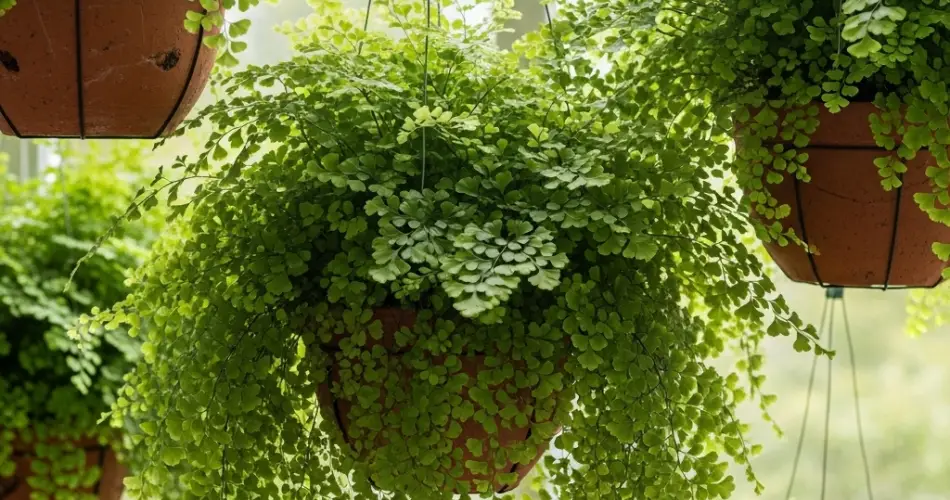Ferns are a timeless favorite in indoor and outdoor gardens, and two of the most popular varieties for hanging containers are Boston ferns (Nephrolepis exaltata) and Maidenhair ferns (Adiantum spp.). These graceful plants bring texture, greenery, and elegance to any space. By growing them in hanging containers, you not only save floor and shelf space, but you also showcase their beautiful cascading fronds in the most eye-catching way.
With the right setup and a few practical care tips, Boston and Maidenhair ferns can thrive in hanging pots indoors or on shaded patios. Here’s how to grow these delicate plants successfully in a suspended environment.
Why Hanging Containers Work for Ferns
Boston and Maidenhair ferns naturally have a trailing or arching growth habit. This makes them ideal for hanging displays where their fronds can spill freely over the edges of the container.
Benefits of growing ferns in hanging containers include:
-
Enhanced display of foliage: The full, layered fronds look more dramatic from above or at eye level.
-
Better airflow: Hanging pots improve circulation around the plant, helping reduce the risk of mold and mildew.
-
Space-saving design: Hanging ferns free up surfaces and add greenery to walls, corners, or ceilings.
-
Humidity optimization: Hanging near bathrooms or kitchens can provide the moisture these ferns love.
Choosing the Right Fern for Your Space
Boston Ferns are lush, hardy, and slightly more forgiving than Maidenhair ferns. They are great for beginners and adapt well to indoor environments when given enough humidity and light.
-
Fronds are long, feather-like, and arching.
-
Can tolerate indirect bright light and average room humidity with regular misting.
-
Grow quickly and fill out baskets beautifully.
Maidenhair Ferns, on the other hand, are delicate, elegant, and a bit more demanding. Their ultra-fine foliage gives them a romantic, almost lacy appearance.
-
Fronds are light, airy, and fan-shaped.
-
Thrive in high humidity and consistent moisture.
-
Best suited for more experienced plant owners or very humid spaces like bathrooms.
Selecting the Best Hanging Container
When growing Boston or Maidenhair ferns in hanging containers, choosing the right pot is essential for plant health and display.
1. Drainage is a must
Ferns hate soggy soil, so make sure your hanging pot has proper drainage holes. If you’re using a decorative hanging basket without holes, keep the fern in a plastic pot inside it, and remove it when watering.
2. Size appropriately
Choose a pot that allows some room for root growth but isn’t too large. A pot that’s too big can hold excess moisture and lead to root rot. Typically, a 6–10 inch diameter container works well.
3. Material options
-
Coconut fiber-lined wire baskets: Allow for great airflow and a natural look, especially for outdoor use.
-
Plastic or resin pots: Lightweight and moisture-retaining, ideal for indoor ferns.
-
Ceramic hanging pots: Stylish for interiors, but heavier and may need sturdy ceiling hooks.
4. Added features
Look for pots with saucers or water reservoirs, especially for indoor hanging to prevent dripping.
Soil and Planting Tips
Ferns do best in a light, well-draining, and moisture-retentive potting mix.
-
Use a mix containing peat moss or coco coir, perlite, and a bit of compost or worm castings.
-
Avoid heavy soils that compact easily.
-
Gently firm the soil around the roots when planting but don’t pack it too tightly.
After planting, water thoroughly to help the soil settle and ensure even moisture throughout.
Ideal Light and Placement
Ferns prefer indirect light and will suffer in direct sunlight.
-
Boston Ferns: Bright, indirect light is ideal—think near east- or north-facing windows.
-
Maidenhair Ferns: Prefer filtered light or even partial shade—perfect near steamy bathrooms or shaded patios.
Outdoors, hang them in dappled shade or under a covered porch. Indoors, avoid placing them directly under air conditioners or next to heaters.
Watering and Humidity
Both Boston and Maidenhair ferns need consistent moisture, but they don’t want to sit in waterlogged soil.
Watering tips:
-
Water when the top inch of soil feels dry.
-
Let excess water drain out completely.
-
Use room-temperature water, and avoid overwatering during cooler months.
Humidity tips:
-
Mist ferns regularly, especially if indoor air is dry.
-
Use a humidity tray or place a humidifier nearby.
-
Bathrooms or kitchens with good lighting are ideal spots.
Maintenance and Care
-
Prune old or brown fronds to encourage new growth.
-
Rotate the pot every few weeks to promote even growth.
-
Fertilize monthly during the growing season (spring to early autumn) with a diluted liquid houseplant fertilizer.
For Maidenhair ferns, be extra careful—sudden drafts, underwatering, or dry air can cause them to decline quickly. Keep them in a stable, humid environment for best results.
Final Thoughts
Growing Boston and Maidenhair ferns in hanging containers is a beautiful way to display these classic houseplants. With their cascading fronds and soft textures, they bring movement and life to walls, corners, and ceilings.
The key to success lies in choosing the right container, providing consistent moisture and humidity, and placing your fern in a spot with bright but indirect light. With just a little care and attention, your hanging fern will become a thriving, show-stopping feature in your home or patio garden.



